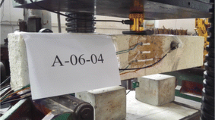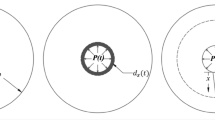Abstract
This paper is devoted to the description of the effects of corrosion on mechanical behaviour of reinforced mortar beams. Corrosion tests have been performed through accelerated tests for two configurations of beams (rebar at the corner or in the middle). Critical times related to the development of cracking have been defined by using strain measurements, potential drop and visual observations. Our results showed that the crack pattern and the kinetic of cracking both depend upon the position of rebar. Furthermore, in order to predict the “times to cracking”, an analytical model (hollow cylinder subjected to inner pressure) was used with a set of experimental data related to the thickness and the displacement of the steel/mortar interface. Our results showed that these times depend upon the outer radius of the used hollow cylinder which is about equal to the length of the through crack.
Résumé
L’objectif de cette étude est de décrire l’effet mécanique de la couche de rouille dans des éprouvettes de mortier armé soumises au processus de corrosion accéléré par imposition de courant pour deux configurations de poutres (armature au coin ou au milieu). Nous avons mis en évidence des temps dits critiques de fissuration par différentes techniques: mesure des déformations, détermination de la différence de potentiel et observations visuelles. Nous avons montré que le faciès de fissuration ainsi que la cinétique de fissuration dépendent de la position de l’armature. De plus, afin de prédire les temps critiques de fissuration, nous avons utilisé un modèle analytique (cylindre creux soumis à des pressions internes) en utilisant des données au niveau de l’interface acier/mortier (épaisseur de la couche de rouille, déplacement). Nos résultats ont montré que le temps de fissuration sur la surface extérieure peut être prédit si le rayon extérieur du cylindre creux est pris égal à la longueur de la fissure traversante.























Similar content being viewed by others
References
Tuutti K (1982) Corrosion of steel in concrete. CBI research report no 4.82. Swedish Cement and Concrete Research Institute, Stockholm, Sweden
Cady PD, Weyers RE (1983) Chloride penetration and the deterioration of concrete Bridge decks. Cem Concr Aggreg 5(2):81–87
Francois R, Arliguie G (1999) Effect of microcracking and cracking on the development of corrosion in reinforced concrete members. Mag Concr Res 51(2):143–150
Broomfield JP (1997) Corrosion of steel in concrete understanding investigation and repair. E&FN Spon Press, London
Alonso C, Andrade C, Rodriguez J, Diez JM (1998) Factors controlling cracking of concrete affected by reinforcement corrosion. Mater Struct 31:435–441. doi:10.1007/BF02480466
Yüzer N, Aköz F, Kabay N (2008) Prediction of time to crack initiation in reinforced concrete exposed to chloride. Constr Build Mater 22:1100–1107. doi:10.1016/j.conbuildmat.2007.03.011
Caré S, Raharinaivo A (2007) Influence of impressed current on the initiation of damage in reinforced mortar due to the corrosion of embedded steel. Cem Concr Res 37:1598–1612. doi:10.1016/j.cemconres.2007.08.022
Caré S, Ngyuen QT, L’Hostis V, Berthaud Y (2008) Mechanical properties of the rust layer induced by impressed current method in reinforced mortar. Cem Concr Res 38:1079–1091. doi:10.1016/j.cemconres.2008.03.016
Ouglova A, François M, Berthaud Y, Caré S, Foct F (2006) Mechanical properties of an iron oxide formed by corrosion in reinforced concrete structures. J Phys IV 136:99–107. doi:10.1051/jp4:2006136011
Ragueneau F, Berthaud Y, Caré S, Nguyen QT, Reviron N (2009) Analysis of the structural behavior of corroded reinforced concrete structures by decoupling the mechanical effects of accelerated corrosion. ACI Struct J (submitted)
Nguyen QT (2006). Étude expérimentale et théorique de l’effet de la corrosion sur la fissuration et le comportement global des structures en béton armé. Thèse de Doctorat, Université Pierre et Marie curie (UPMC) [in French]
Andrade C, Alonso C, Molina FJ (1993) Cover cracking as a function of bar corrosion: part I – experimental test. Mater Struct 26:453–464. doi:10.1007/BF02472805
Nguyen QT, Caré S, Millard A, Berthaud Y (2007) Analyse de la fissuration du béton armé en corrosion accélérée. C R Mec 335:99–104. doi:10.1016/j.crme.2007.01.005
Nguyen QT, Millard A, Caré S, L’Hostis V, Berthaud Y (2006) Fracture of concrete caused by the reinforcement corrosion products. J Phys IV 136:109–120. doi:10.1051/jp4:2006136012
Fang C, Lundgren K, Cheng L, Zhu C (2004) Corrosion influence in reinforced concrete. Cem Concr Res 34:2159–2167. doi:10.1016/j.cemconres.2004.04.006
Timoshenko SP, Goodier JN (1970) Theory of elasticity, 3rd edn. Mc Graw-Hill, New York
Liu Y, Weyers RE (1998) Modeling the time-to-corrosion cracking in chloride contaminated reinforced concrete structures. ACI Mater J 95-M 65:675–681
Bhargava K, Ghosh AK, Mori Y, Ramanujam S (2005) Modeling of time to corrosion-induced cover cracking in reinforced concrete structures. Cem Concr Res 35:2203–2218
El. Maaddawy T, Soudki K (2007) A model for prediction of time from corrosion initiation to corrosion cracking. Cem Concr Compos 29:168–175. doi:10.1016/j.cemconcomp.2006.11.004
Ohtsu M, Yosimura S (1997) Analysis of crack propagation and crack initiation due to corrosion of reinforcement. Constr Build Mater 11(7–8):437–442. doi:10.1016/S0950-0618(97)00020-2
Acknowledgments
This research has been supported by CEA (French Atomic Energy Commission), EDF (Electricité De France) and LCPC (Laboratoire Central des Ponts et Chaussées). The study is part of the CIMETAL program of CEA. The authors are grateful to Paul Bujar and Jean-Pierre Martineau of the Civil Engineering Department of the “Ecole Normale Supérieure de Cachan (ENS Cachan) for the casting of the beams and the strain measurements by gauges.
Author information
Authors and Affiliations
Corresponding author
Rights and permissions
About this article
Cite this article
Caré, S., Nguyen, Q.T., Beddiar, K. et al. Times to cracking in reinforced mortar beams subjected to accelerated corrosion tests. Mater Struct 43, 107–124 (2010). https://doi.org/10.1617/s11527-009-9474-2
Received:
Accepted:
Published:
Issue Date:
DOI: https://doi.org/10.1617/s11527-009-9474-2




